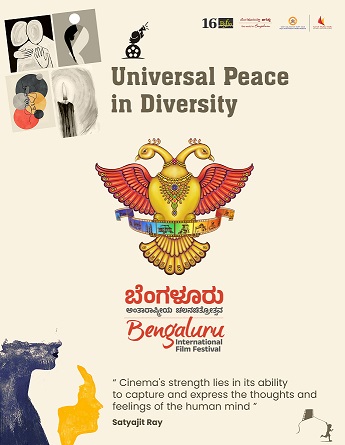BIFFes 16, 2025: The flicks, picks and my jinx, Part
II

BIFFes 16, 2025: The flicks, picks and my jinx, Part II
My third visit to the Bengaluru International Film Festival (BIFFes) in three decades was enjoyable and comfortable. However, my selection of films to watch was jinxed, with very few movies meeting minimum expectations. Not surprising, considering the same had happened at the International Film Festival of India. As a critic, I prefer to pick films without doing any background reading or asking people who might know somethings about them. That’s a conscientious decision, making me a completely uninfluenced audience. If you know a few things about a movie, they might colour the impact they make on your mind. In the last instalment, I ended with The Hyperboreans, which came from Chile. Let’s move on.

Pyre, from India, was the opening film, but I saw it at a subsequent, repeat screening. It competed in the Asian Competition section. I had admired director Vinod Kapri’s Pihu (2021), which could move even the stone hearted. Having no idea whether at least part of it was real-life footage, I could only applause the way he moulded a two-year-old girl into delivering a superlative ‘performance.’ If Pihu was about a little girl who is alone in a skyscraper and tragedy can befall her at any moment, Pyre was about a couple in their late 70s/early 80s, who live in a far-off mountain village in Uttarakhand. They had a son, who left decades ago, for greener pastures. Non-actors, both, the man and the woman, shone in their natural surroundings. Once again, like in Pihu, your heart wept at their plight, and their dogged resistance to all suggestions to move to another, more populated and more accessible place. And you applauded the bravado of these determined souls, who have only some cattle as their wealth. Comparison was inevitable. Pihu and Pyre have so many common sentiments and situations, although the locales and the canvas are vastly different. As I told Vinod after seeing the film, Pyre was a very good film, and won a Special Jury Mention, but Pihu still retained its place in my heart, a rung above.

Another Indian entry that I saw and appreciated its theme, also in the Asian Competition Section, was Feminichi Fathima, from Kerala, directed by debutant Fasil Muhammed. It tells the tale of a couple in orthodox Kerala where the man feels that his wife is getting too big for her boots. A simple incident, like their son wetting his mattress creates a situation where Fatima takes a stand. In spite of living in a strict Muslim environment, she makes it a point to fulfil her desire to buy a new mattress. Feminichi Fatima, meaning Fathima, the Feminist, got a Jury Special Mention, shared with Pyre. For me, it held limited appeal and had very little to say, though it said it well. Fire-brand feminists might consider Fathima’s victory a small step, but down South, in her environs, it is nothing short of a winning goal.
In the Belly of a Tiger (India, director Jatla Siddartha) promised a lot, but delivered much less. This Controllable Crowd (Iran, Mohammad Matin Ojani) could not control my urge to head towards the exit. This too was part of the Asian Competition Section. And that all the exposure I had to this section. Coming to the Indian Competition, five films must be mentioned: Beline (meaning outside the line, the non-conformist, Director Samik Roy Choudhury), Humans in the Loop (Aranya Sahay), Level Crossing (Arfaz Ayub), Rador Pakhi (Dr. Bobby Sarma Baruah) and Swaha (Abhilash Sharma). As it happened, I saw all five after BIFFes, so I shall reserve my comments.
The next section was the Kannada Competition section. Here, I saw only Venkya, and I saw it not at BIFFes, but later, so again, no comments. FIPRESCI co-ordinated a critics’ week, wherein, I only managed to catch Who Do I Belong To (Canada/France/Tunisia) Meryam Joobeur), not a good choice.
Coming to Contemporary World Cinema, there was Moon, a film from Austria, about an Austrian woman who is hired by a Middle East family to train three sisters in physical fitness and martial arts. Exciting premise, but not much delivered. Turkey’s One of Those Days when Hemme Dies (Murat Firatoglu), had a lot of tomatoes. I cannot remember much else. Yasha and Leonid Brezhnev (Edgar Baghdasaryan) was one film in this section that I had seen before the festival. The film plays with form and time, occasionally bringing up nuggets of European/Russian history. Not the common man’s cup of tea, it might appeal to those who aware politically and historically aware of the last 50 years.
Skipping the Country Focus on Brazil and Georgia, just because I had no time to address it, I walked into an auditorium which was screening a biopic about a swimming champion, a middle-aged lady, called The Swedish Torpedo (Freeda Kempff). Biopics need to be razor sharp to hold my interest. Unfortunately, this one did not hold water. There was a section on Universal Peace in Diversity that I had to miss, and then there was a Retrospective of masters like Krzysztof Kieslowski and Wim Wenders. Having seen some of Kieslowski’s films earlier, I caught-up on Camera Buff, and from the Wim Wenders’ selection, I managed Kings of the Road. My Homages, Remembrances and Centenary Tributes to the personalities who were honoured by BIFFes with screenings of their films.
Three visits in 30 years is certainly not a good record. I look forward to the next invitation from BIFFes, hoping it comes in 2026, when I will be able to manage my time better, and, providence willing, see more good films than avoidable ones. This ends my coverage of the Bengaluru International Film Festival No. 16, 2025.
72